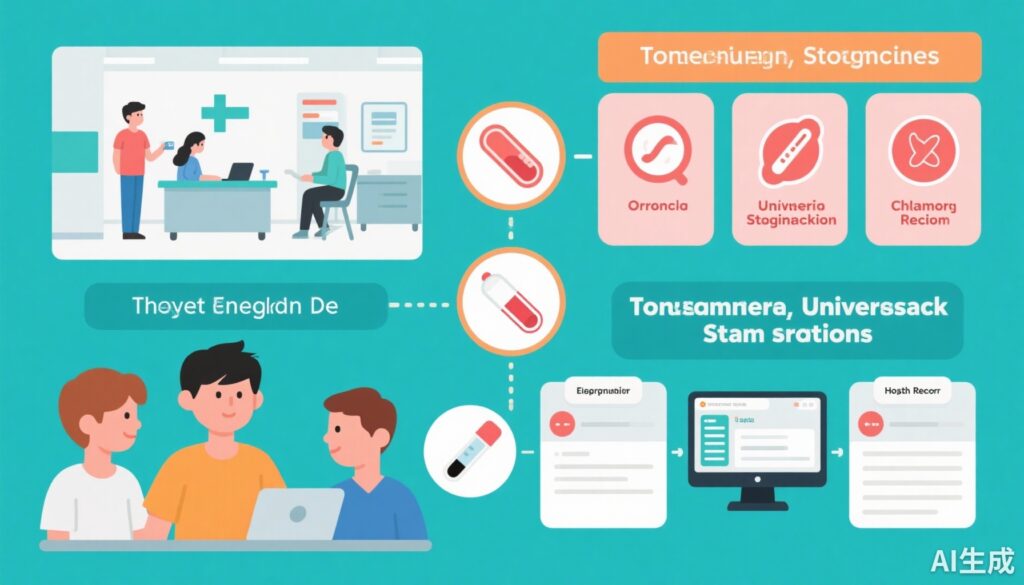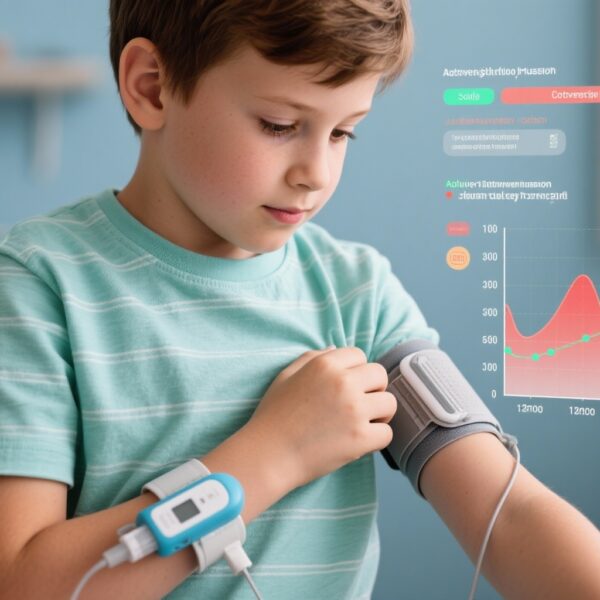Highlights
- Adolescents and young adults represent a substantial proportion of US sexually transmitted infection diagnoses, yet systematic screening for gonorrhea and chlamydia in emergency departments (EDs) is not standard.
- A multicenter pragmatic trial comparing usual care, targeted, and universal screening approaches found that targeted screening using electronic health record–embedded risk assessment tools resulted in the highest population-level detection of infections.
- Brief educational interventions in ED settings have limited impact on increasing STI testing uptake among young women, underscoring the importance of integrated, systematic screening processes rather than reliance on patient or clinician-initiated testing.
- The findings support implementation of broad-scale, systematic gonorrhea and chlamydia screening in pediatric EDs as a critical public health strategy to improve STI detection and reduce transmission among adolescents.
Background
Adolescents and young adults aged 15 to 24 years account for nearly half of the estimated 2.5 million new sexually transmitted infections (STIs) diagnosed annually in the United States. Gonorrhea and chlamydia infections are particularly prevalent in this group and are often asymptomatic, contributing to underdiagnosis and ongoing transmission. Untreated infections can lead to serious reproductive health complications including pelvic inflammatory disease, infertility, and increased susceptibility to HIV acquisition.
Emergency departments serve as a primary source of health care for many adolescents, often representing their main point of clinical contact. However, unlike outpatient or sexual health clinics, there are no widely accepted guidelines or policies for routine gonorrhea and chlamydia screening in the ED setting for adolescents. Screening practices are frequently limited to symptom-driven testing or clinician discretion, which results in missed opportunities for detection in asymptomatic individuals.
Given this clinical gap, it is imperative to evaluate effective strategies to increase detection of gonorrhea and chlamydia infections in this high-risk population within emergency care environments.
Key Content
Comparative Effectiveness Trial of Screening Strategies in Pediatric Emergency Departments
The landmark study by Reed et al. (2025) addressed this gap by conducting a multicenter, pragmatic, type 3 hybrid stepped-wedge crossover trial across six pediatric EDs in the United States. Over approximately 20 months (January 2021 to September 2022), the trial enrolled 98,413 patient visits of adolescents aged 15 to 21 years. Key exclusion criteria included critical illness, inability to provide informed consent, cognitive impairment, and cases involving sexual assault concerns.
Three sequential screening phases were compared:
- Usual Care: Standard practice prior to integration of sexual health surveys or electronic risk scores; clinician discretion determined testing.
- Targeted Screening: Patients completed a computerized sexual health survey; a validated behavioral risk score was integrated into the electronic health record (EHR) to provide clinical decision support, guiding clinicians to offer gonorrhea and chlamydia testing to higher-risk patients.
- Universally Offered Screening: All patients were offered gonorrhea and chlamydia screening regardless of risk score, with clinical decision support based solely on patient opt-in; EHR did not reveal risk survey information to clinicians.
Testing was performed via urine-based nucleic acid amplification assays, with detection rates measured per 1,000 eligible patients every two weeks during each phase.
Results Summary
– Patient distribution: 18,633 visits during usual care (19%), 41,082 during targeted screening (42%), and 38,698 during universal screening (39%).
– Demographics: Mean age 17.03 years (SD 1.42), majority female (57.9%), predominantly aged 16–18 years (51.7%).
– Testing rates: 1,432 tests ordered in usual care, 3,216 during targeted screening, and 2,855 during universal screening.
– Detection rates (adjusted difference in infections detected per 1,000 visits vs usual care): Targeted screening +2.59 (95% CI, 2.46–2.73); Universal screening +1.81 (95% CI, 1.67–1.94).
These findings highlight that targeted screening leveraging EHR-based risk scoring identified more infections than universal screening, though both outperformed usual care significantly.
Supplementary Evidence from Interventional Trials in Emergency Settings
Two randomized controlled trials adding context to engagement and behavior modification in the ED setting offer complementary insights:
1. Brief Educational/Counseling Intervention for Young Women (CDC-funded, 2014)
In a randomized trial enrolling 171 sexually active women aged 18–35 years in two EDs, a brief counseling intervention focused on personalized STI risk and condom use did not significantly increase acceptance of free chlamydia and gonorrhea testing. Testing uptake was 48% in the intervention group versus 36% in controls, without statistically significant differences. Notably, women at high behavioral risk were not more likely to accept testing, suggesting that standalone brief interventions may be insufficient to enhance testing rates in this population.
2. Brief Motivational Intervention in Drug-Positive Adults (2012)
Among out-of-treatment heroin and cocaine users aged 18–54, adding a brief motivational intervention to standard voluntary counseling, testing, and drug treatment referral did not significantly reduce sexual risk behaviors or incidence of chlamydia/gonorrhea infections over 6 to 12 months follow-up. This underscores the complexities of behavior modification in high-risk ED populations and the importance of systematic testing and linkage strategies.
Expert Commentary
Reed et al.’s trial provides critical evidence supporting the integration of systematic STI screening strategies within pediatric emergency departments, traditionally non-specialist settings for sexual health care. The robust stepped-wedge crossover design, large sample size, and pragmatic approach to workflow integration enhance the generalizability and clinical relevance of these findings.
The superiority of targeted screening based on validated risk scores integrated into the EHR reflects the benefit of precision medicine approaches in infectious disease detection. Such algorithms operationalize behavioral risk data into actionable clinical prompts, improving test ordering efficiency and yield. Universal screening, while intuitively appealing for comprehensiveness, may overburden resources and result in lower per-test positivity compared to targeted approaches.
However, the limited impact of brief counseling or motivational interventions on testing uptake and sexual risk behaviors documented in prior RCTs confirms that screening implementation in EDs should prioritize system-level integration and clinician decision support over reliance on patient-driven acceptance or standalone educational counseling.
Mechanistically, asymptomatic gonorrhea and chlamydia infections in adolescents often evade identification without proactive screening, perpetuating transmission chains. Embedding risk assessment and decision support within ED workflows facilitates earlier diagnosis and treatment, mitigating complications and onward spread.
Current public health guidelines from the CDC emphasize annual gonorrhea and chlamydia screening for sexually active women under age 25 and suggest risk-based screening in men who have sex with men; however, explicit ED-focused screening recommendations remain absent. This trial’s findings argue for guideline updates to endorse systematic screening policies within emergency care settings for adolescents and young adults.
Challenges to implementation include ensuring confidentiality, integrating screening without disrupting ED flow, and securing linkage to care for positive cases. Institutional commitment, staff training, and patient engagement strategies will be essential for sustainable program success.
Conclusion
Systematic gonorrhea and chlamydia screening in adolescent emergency departments significantly improves infection detection compared to usual care. Targeted screening using validated behavioral risk scores integrated into electronic health records yields the highest population-level infection identification, balancing resource efficiency with diagnostic yield. Universal screening also increases detection but to a lesser extent.
Prior interventional trials demonstrate that brief educational or motivational interventions alone do not reliably increase testing uptake in ED populations, emphasizing the necessity of integrated screening workflows supported by clinical decision support tools.
Given adolescents’ disproportionate STI burden and frequent reliance on emergency care, integrating validated, large-scale screening processes into pediatric EDs is a critical public health priority. Future work should focus on optimizing workflow integration, ensuring follow-up and treatment, and exploring patient-centered barriers to testing acceptance.
References
- Reed JL, Palmer CA, Casper TC, Augustine EM, Cruz AT, Elsholz CL, et al. Gonorrhea and Chlamydia Screening for Adolescents and Young Adults in Emergency Departments. JAMA Pediatr. 2025 Sep 8:e252139. doi:10.1001/jamapediatrics.2025.2139. PMID: 40920405; PMCID: PMC12418219.
- Levy SJ, Johnson MD, Wagoner KL, et al. A randomized controlled trial of the effects of a brief intervention to increase chlamydia and gonorrhea testing uptake among young adult female emergency department patients. Acad Emerg Med. 2014 Dec;21(12):1512-20. doi:10.1111/acem.12539. PMID:25491714.
- Samet JH, Horton NJ, Meli S, et al. The impact of a brief motivational intervention on unprotected sex and sex while high among drug-positive emergency department patients who receive STI/HIV VC/T and drug treatment referral as standard of care. AIDS Behav. 2012 Jul;16(5):1203-16. doi:10.1007/s10461-012-0134-0. PMID:22261830.
- Centers for Disease Control and Prevention. Sexually Transmitted Infections Treatment Guidelines, 2021. MMWR Recomm Rep. 2021;70(4):1-187. doi:10.15585/mmwr.rr7004a1.



